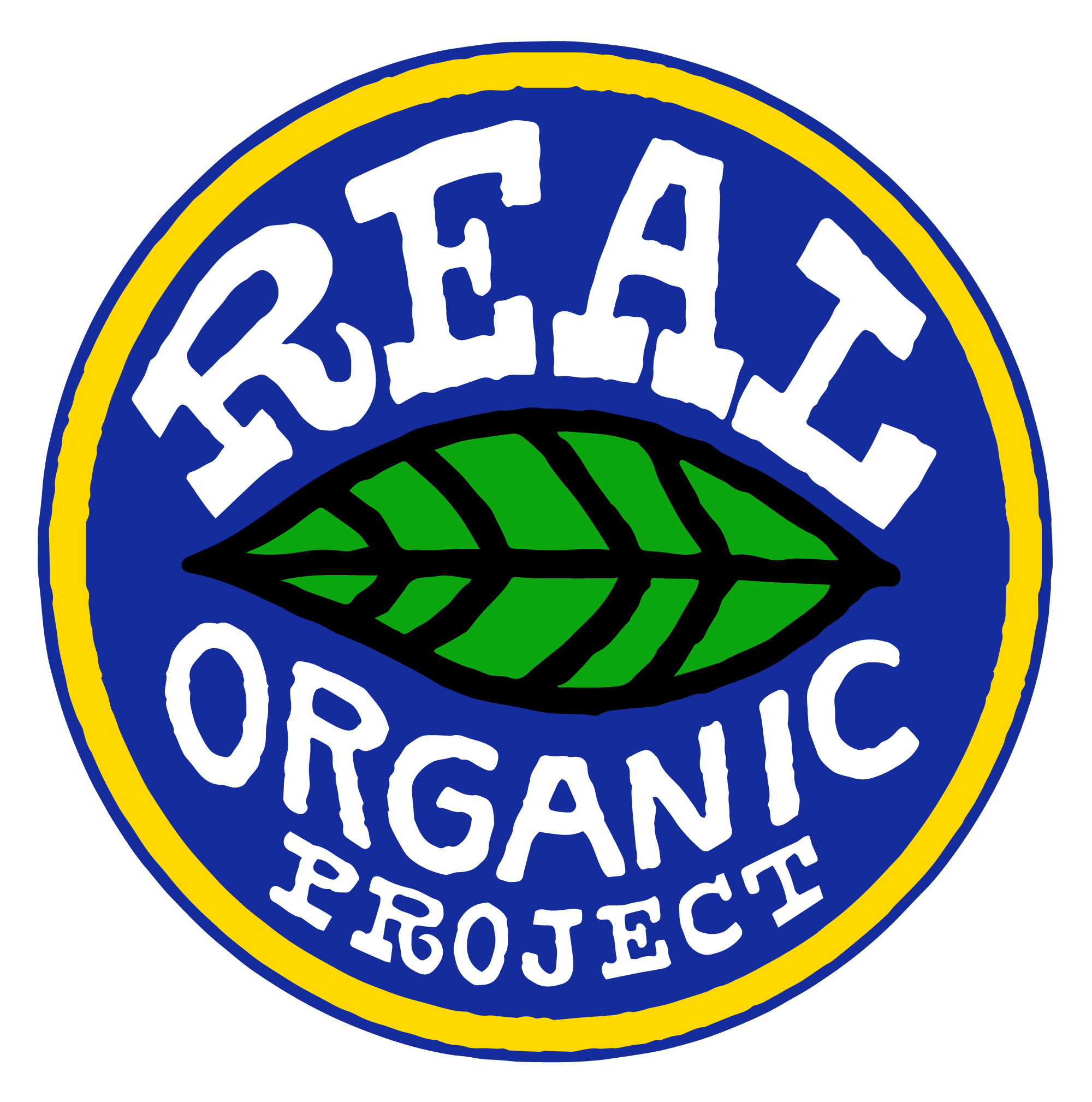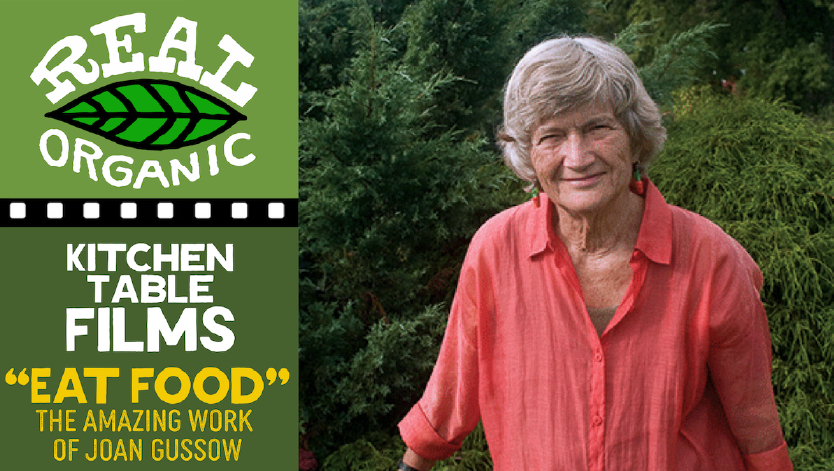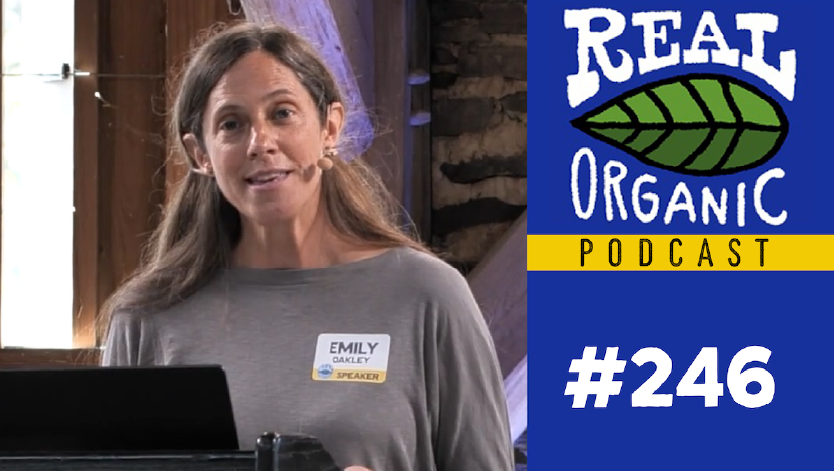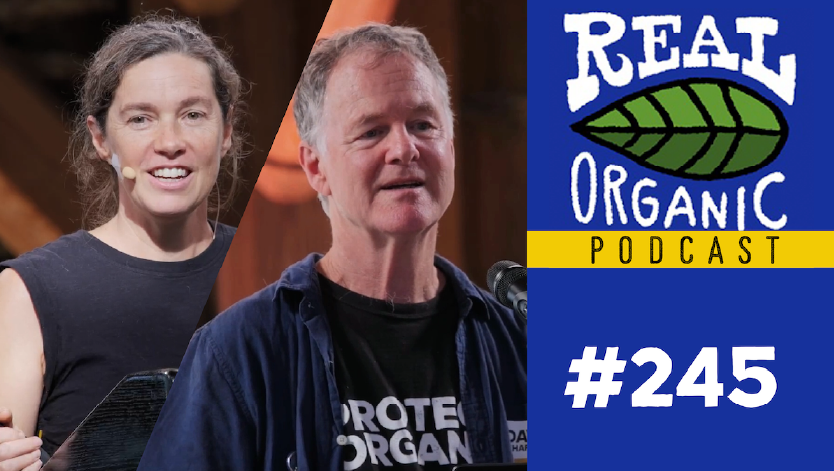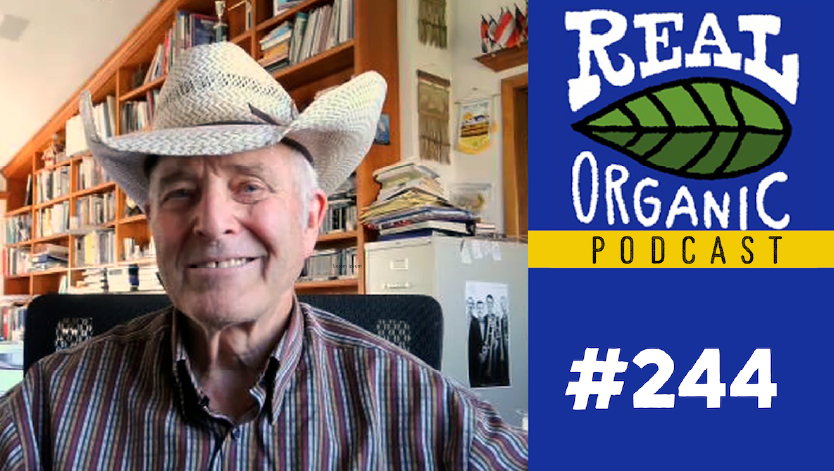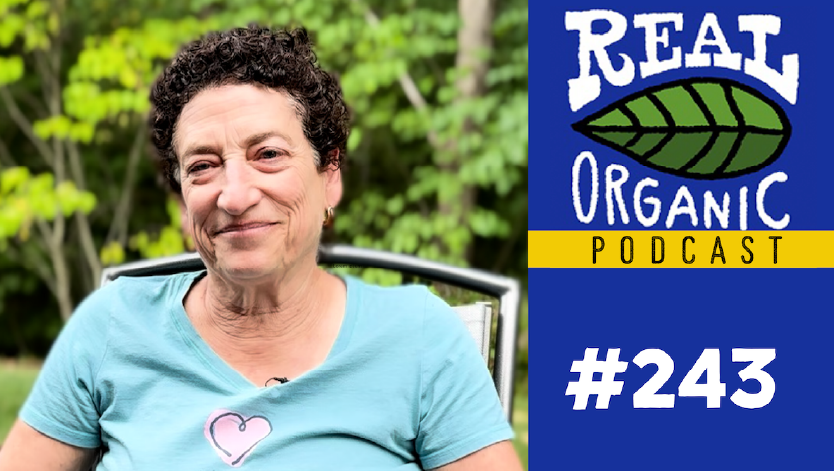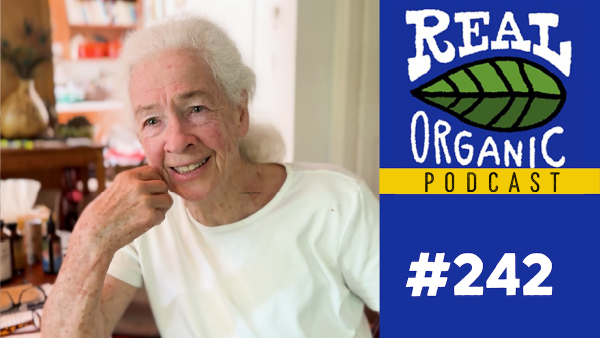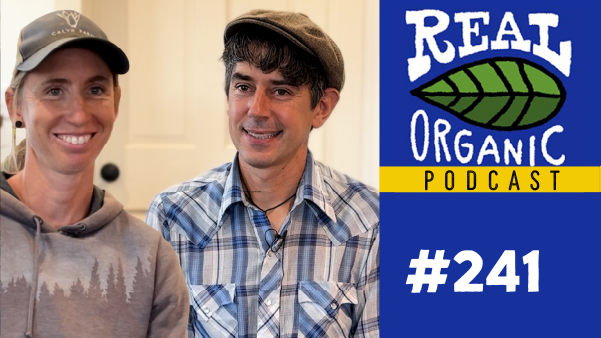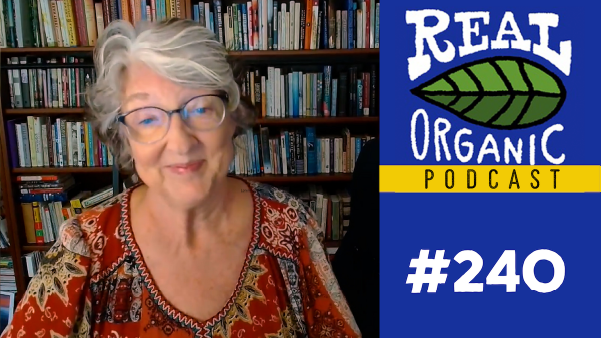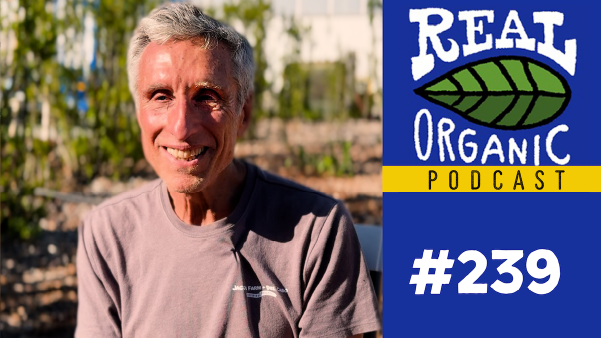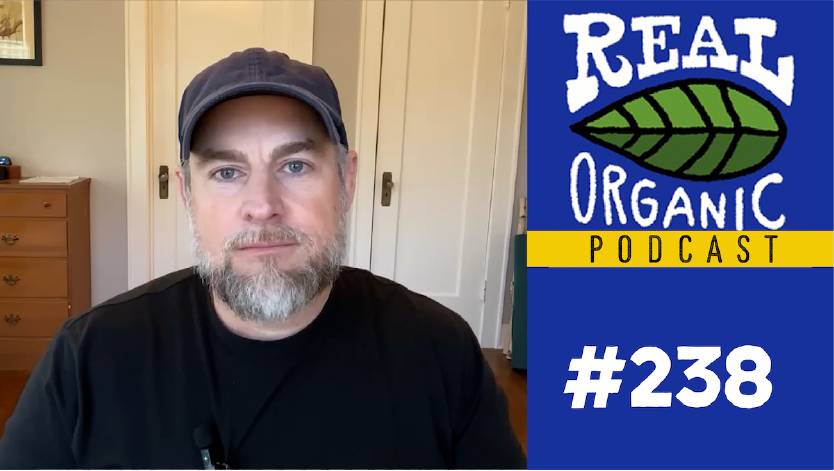Episode #155
Reginaldo Haslett-Marroquin: The Need For A Real Regenerative Movement
Welcome! You can subscribe and download episodes of our show through your favorite podcast app.
You can also subscribe to receive the video version of each episode on our YouTube channel.
Our Reginaldo Haslett-Marroquin interview has been edited and condensed for clarity.
Reginaldo Haslett-Marroquin speaks at the Saving Real Organic Conference at Churchtown Dairy in Hudson, NY, October 14, 2023
Linley Dixon 0:00
Our next speaker is Reginaldo Haslett-Marroquin. And he’s going to talk to us about Tree Range Farm. So listen carefully there. There’s a “T” in Tree Range Farms. And it’s actually a cooperative of farmers that are grazing chickens underneath trees. Paul Hawken is one of the advisors to the Real Organic Project. And when he wrote Drawdown, he said silvopasture, which is running animals underneath trees, is, I think it was number four, it was in the top 10 of things that we must do in order to fix the climate crisis. So, Regi..
Reginaldo Haslett-Marroquin 0:41
Buenos Dias. And thank you, Francis, for raising that energy. That’s really cool. I’ll be representing Tree Range Farms, which is the go to market strategy of an ecosystem of businesses. Where we have literally built a supply chain from grain, from aggregation of grain, to production of poultry, to the processing of poultry, to the branding, distribution and everything. For, for us, the whole idea of regeneration really, is ends with the or, or is fully inclusive of the land. But it starts with who owns, who controls, and who gets to make the decisions about what happens on the land.
Reginaldo Haslett-Marroquin 0:47
That’s where regeneration starts. And that’s what we lost, we lost the ownership control and governance of the system. And that’s why we are now being really everything, almost we do turn around and everything is fake, there is very few things that are real. And I’m so happy to be here with a real people, with a real food, with a real you know, what I say insurgents in this intellectual battle against the fake stuff that is embedded as in starting to colonize all the way to our minds.
Reginaldo Haslett-Marroquin 1:56
So that’s why I’m here. That’s why I am grateful to be here as well, because you’re the real people. And that really means a lot to me, I’m a Guatemalan, I was four years old, when the war started, the Civil War. I was, I had been here four years before he then, just to give you an idea of the kind of not, you know, this whole thing about fighting systems, I really don’t like that the fighting thing is, I rather be working on building the stuff we want, and coming together like this and not giving an inch, that really is how we’re gonna get there. And so, so we need a real regenerative moment, we need a Real Organic Moment, we need a real food moment, like a real dairy barn, you know, National Movement. I mean, we need everything real again, let’s make America real again.
Reginaldo Haslett-Marroquin 2:53
So it’s critical to understand that regenerative agriculture, for a lot of us, it really started by understanding our ancestral roots. My great grandfather and my great grandmother were talking about regenerating the landscape where we farmed. They learned that from many generations before that, all of the, all of the elders that I have been lucky to be educated by, you know, different from the schools, which domesticate you, our elders educated us. And so that, that’s another play of words that we got to get straight. And so, and I am learning so much about words from Abby, because it’s just like you are the word master. I really like that. Nobody gets through with a wrong word. That’s good.
Reginaldo Haslett-Marroquin 3:46
So anyway, but regenerative, regenerative to us, it’s really a way of thinking it’s a way of being of relating a working of knowing, in a way of relating, especially to the living systems of the planet. That’s what regenerative is about, we kind of tend to reduce things into these phases, so we can manipulate them. And that’s what we call mental colonization. And we shouldn’t do that.
Reginaldo Haslett-Marroquin 4:08
So let’s keep that in mind as we think about what we’re doing here. How are we are taking this, this issue of collective ownership and control governance and all those whole systems thinking as the centerpiece of how we build real regenerative, the next real regenerative movement, alongside the Real Organic and all these other things that we have to do, right. So for us, it’s critical to understand this. The whole thing of farming has very little to do with production of anything.
Reginaldo Haslett-Marroquin 4:41
We are simply stewards of processes of transformation of energy, Which through the biophysics and the chemistry of the planet that evolved over billions of years, energy goes from non-edible to us, to edible to us, whether it’s milk, whether it’s eggs, whether it’s lettuce, Let us it was first co2 and nitrogen hydrogen know that. And through those processes it became what we harvest. But we are harvesting what? Energy not a product. Product is the word of the extractive colonizing system that seeks to maximize whatever comes out of the land, we don’t do that in regenerative thinking, we harvest the energy. And because of that, we have to optimize where that energy is transformed.
Reginaldo Haslett-Marroquin 5:27
There’s three places on the planet where that is happening. Photosynthesis, the most important part, because that’s where it all begins. The participation of animals, because animals are the most effective transformers of the outputs of photosynthesis. You take a hay bale and you put it out there in a compost pile, it will take a year before his soil, you take that camp, that bale and put it into a cow, and 48 hours later is being pooped, and peed. And then another 40 hours later, it’s starting to become nutrients for everything that wants to do photosynthesis again. And that’s how brilliant the process and magnificent the design is. And that is what allows for the energy flows to be more than the energy that we harvest. And that is what we call the regenerative factor is energy. Is not no till, it’s not the it’s not like cultural practices. It’s a factor that is scientifically verifiable. And so that’s how they animals at the end of the day, you know, in the soil, you know, on the bottom, close that loop, three of the places where energy is transformed on a planetary basis.
Reginaldo Haslett-Marroquin 6:38
So for us, it was important to take the chicken, it’s a long story. But just to be clear, I really speak for the chickens when I say that they are not only a jungle fowl, but also look from their perspective, the world looks very different if you actually start to think, real, real regenerative means looking at the world from the perspective of the organisms you are working and relating and knowing with.
Reginaldo Haslett-Marroquin 7:07
So a lettuce sees the world one way, a cow does it a different way, a chicken does it in a different way. That’s all we did. Tried to get as indigenously connected intellectually, with what the chicken sees. And that’s where our design, all the ergonomics come from. So in this context, the chicken is part of this three spaces where energy has been transformed chicken is the livestock that we chose to make a point about how we can do real regenerative. So, so we came into this space to optimize those bio physics and chemistry. And you know, you all know very well that those those factors are governed by the laws of thermodynamics that establishes that energy can only be transformed, it cannot be created or destroyed. And so that’s what we are doing is the same energy that was here on the planet many billions of years ago. And hopefully, we don’t ship too much more into space, so we can keep some of it. So we see the chicken in the middle of that, where we harvest some of the first energy we harvest is from the perennial crops that as a jungle fowl, we have to put it under this environment where it evolved over millions of years. And so as we do, that, those perennial crops are, are central to that environment for, for the poultry to thrive. And I could give you books on how this has resulted in this optimal conditions not only for the health of the animal, but for the efficiency of the energy transformation process, and all of that.
Reginaldo Haslett-Marroquin 8:50
So we get to harvest energy over and over as we put this, this system to work. The first again is the fruits and veggies and nuts, mostly that we are able to harvest out of the upper level of the poultry environment. On the ground we’re sprouting grains that are large scale so that we can start moving away from feed and all of those other inputs that are needed. The what is not edible to us immediately is edible to trillions of other creatures, like the manure and the feathers and giblets and all of that, which then we move that energy, we’re now moving that into the fields where the grain is being grown, it is literally manure spreading.
Reginaldo Haslett-Marroquin 9:29
Okay, I’m just making it a little bit fancier so that you guys ought some of that energy is going into vegetable production. We have tested 250 different vegetable varieties. One of the things you may want to know is that Bolger manure has all of the 13 basic elements that every plant needs to thrive to be successful as an expression of its own genetics. And so this is really fascinating because now we can start bringing ancestral medicines and all of that and it’s all because of the chicken. This is what you know, I figured that we are on the other side of the, you know, France is with the cows as with the chickens and like we start putting that together and we get gather real regenerative moment. When we get all of the livestock sectors together and start taking over the USDA and all those other departments that are actually, you know, I mean, they were taken over already. So why couldn’t we take them over again? Like, it’s like, why not? Right? And I love this and, you know, the Real Organic Standards Board something like, dang, that was brilliant. And we need to make that now that the Real Standards Board, you know what I mean, rather than the one we have. So that gives you an idea of how we structure this, this idea of real regenerative, again, it’s about the mindset, it’s about how we decolonize our minds so that we can see the other 95% of the potential the landscape that we don’t see through the colonizers lens of extraction and expropriation and all of those urges that have actually led us to where we are.
Reginaldo Haslett-Marroquin 11:02
In this case, you take the poultry comes a day old, they stay in the barns for four weeks, because they are too small to be ranging up to four weeks now in that time, we have been preparing the landscape outside. In this case is literally dozens of different native species and forages and all of that grain that has been spread right before the chickens are gonna start ranging and then continuing to do that. And when there is no canopy yet, we can build that canopy with sunflowers, corn, in my case, edible corn from which we make tortillas. And it’s ancestral, I mean, all of this is part of that process. We don’t move the buildings because honestly, we don’t have to. All of the energy and now there’s three years later of scientific verification of that energy flow, we know that. And then 15, 17 years later, after the first unit was built, everything is flourishing in there, there is no excess nutrients, there is no bare ground, it’s all covered. And by the way, the problem is that if we don’t have chickens there, it just takes over, is like so productive now.
Reginaldo Haslett-Marroquin 12:11
And so, you know, chickens are happy, we’re happy, there is very little labor because chickens are really good laborers themselves. And that makes us, if you want to call it from a colonizer perspective, efficient, right? But not only that, we took that and then said, okay, how many units can we put on a farm so that we can actually balance out the output of manure with the landscape we have available and then thinking not only of the farm, but if a farmer, for example, comes in like in my condition with no land, and I only have access to a few acres, and I don’t have land to put the manure into. Because the manure in the barns has been collected and then then moved outside of the chicken areas. Then we that’s what we build systems of farms instead of single farms. And so now coordinated, we always have more landscape than we have manure for. And that we’re going to keep that ratio so that we always keep that balance of energy flows. Not on a farm level necessarily, but thinking on the system level. Why?
Reginaldo Haslett-Marroquin 13:12
Because regeneration doesn’t happen on a farm or because of a product. Regeneration is an ecosystem function. Let’s keep that in mind, its an ecosystem function, not a farm level function. And the farm contributes to it. Yes. And we buy we got to coordinate across regions in order to achieve regenerative outcomes. And that’s a big difference between the fake stuff regenerative you know the use of the regenerative ward out there for the purpose of profit versus the real thing. So, I will keep introducing you to the chickens.
Reginaldo Haslett-Marroquin 13:51
At four weeks they start being trained to be outdoors. Those are hazelnuts, by the way native to two thirds of the continental US, just to give you an idea of the magnificent capacity of this country to do real regenerative poultry.
Reginaldo Haslett-Marroquin 14:10
Okay, now you see how close those trees are to the barn, and they are lush and they produce two and a half times more nuts, then the trees outside of that fence. To give you an idea of this this balance that we’re able to achieve now this is the same flock. This is my wife and me. And this is the no morning chores. You put the feed out, you go open door and, these are the same birds, the slow growth 70 days later, they’re about to have their one bad day. Still running and jumping and taking leaps like they did on the first day.
Reginaldo Haslett-Marroquin 15:01
Okay, so then organic matter, right, so we take all of this material, we mix it at a, so that we can get that 40:1 carbon to nitrogen ratio. And now we have this larger scale mixing of slow release fertilizers that will get bring into this space where there is no chickens, we don’t want chickens running around everywhere. So we got this structured really professionally so that we can build, you know, curriculum and processes and verifiable systems, you know, scientific processes to monitor what’s going on there. And all of that scientifically verifiable, economically viable, socially compatible with us, because we, you know, socially compatible with a farmer with 1.5 acres, that’s the unit of production. It’s just, you hit all of the engines, that is what regenerative is about, getting everything, not just one thing, so you can make a buck out there by calling something regenerative.
Reginaldo Haslett-Marroquin 16:03
For us, the hazelnuts are central. Because hazelnuts are native to this ecology. They produce the same amount of biomass as soybeans per acre, need no tilling, need nothing except the chickens, of course. But it’s also more nutritious. It’s got protein levels, similar or above soybeans, for example, it’s actually a perfect substitute for soybeans in the Midwest. Because it’s not only native, but it is symbiotic to so many other species that can be supported.
Reginaldo Haslett-Marroquin 16:36
We can literally restore the water systems. In fact, our hazelnuts are now clogging all of the drain tile that was on the farm that I bought, I don’t even need to drip it because the hazelnuts will clog the heck out of them. And then our water gets to stay on the farm. In the bottom, I did dig a whole bunch of pools so that the drain tile that is draining the water actually still stays on the farm right.
Reginaldo Haslett-Marroquin 17:00
So anyway, just to give you an idea of the kind of work that we have been doing on this. All the biomass is then turned around mix with the manure so we can grow again. Almost every vegetable we have tried including our garlic, our heritage beans from Guatemala, heritage corn, and so on. With the only input being wood chips, organic matter, poultry manure, and as we scale this, we can now see we also scaling that whole sector, including pollinators.
Reginaldo Haslett-Marroquin 17:31
But here’s something, this is the land I bought. This is where it is. This is where I started to put up pasture right away, because that puts cover, then we planted when we restored the waterways. Then we planted 8,200 hazelnuts. The idea is the whole farm the whole sixty five acres will look like this, chicken Heaven is what I call it.
Reginaldo Haslett-Marroquin 17:57
So as we do this, the businesses around it also start to evolve. From the chicken and the egg. Now no longer talking about a farm but regions of farms, we can aggregate the production for the poultry processing facility, for example. So I went ahead and bought a meatpacking facility at Astacio, Iowa. And now we’re deploying more farms around the system. We are also looking for partners, the native communities with larger waterways. So we can take the byproducts from the plant, that energy moving into the fish population, because cross species feeding is actually good in nature, right. And so then we take those products, the outputs from those different places, you mix them up with the vegetable leftovers, and you have feed that can go back to the chickens, and so on, feed supplements, and value added products, transportation, warehousing, technical assistance that we just launched a new fund to capitalize the system. And on, and on it goes. And now what you have is a business ecosystem centered on poultry. That’s what we call real regenerative. It’s not about no-till or any of that stuff right. So now we are talking about regions, now we are talking about taking over the space that we gave up. That’s where we are coming from.
Reginaldo Haslett-Marroquin 19:19
And so our next big step is ensuring that we start talking about governance and this is why I love this whole, you know real regenerative standards board because that to me represents a governing body that is actually real. And so we need governing bodies like that in every sector. We are building now, the region’s the poultry Council of America. And the idea would be that then representatives from there could end up being that they know this region’s feed into the national board so we can end up hopefully, eventually, with a Real Regenerative Organic Council of America. You at that point we truly take over the USDA. That’s my dream for governance.
Reginaldo Haslett-Marroquin 20:10
And it’s so doable. More doable than anybody thought was to one, meet the massive Guatemalan army, survive it and actually not lose to them. At the peak of our insurgency, there were only 10,000 effective rebels and over 980,000 soldiers tried to kill us. And yet they couldn’t win.
Reginaldo Haslett-Marroquin 20:37
And this is the message I want to leave you with. We are engaged, not in a Real Organic or a real regenerative, we are engaged in an intellectual insurgency. That is the real thing we’re in. And these are the tools we’ll use to organize and to win. That’s what I’m here for.
